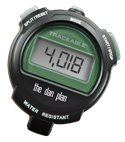Guest blog from Goal Guy Stuart
My go-to goal man Stuart (he has helped me plan out my target goals for the past year and is developing the attack plan with me for the future) offered a guest blog this week and I think he has some great points in it. Rather than carry on, here is hit blog post:
You may have heard executives bemoaning that their projects would have gone better if they hadn’t been unlucky; “…And then the contracts took much longer to finalize, and then we had to raise additional capital, and then we lost the chief strategist, I mean, who could have foreseen that!” But being truthful, these are completely typical of corporate project. The executive that deludes himself otherwise is not taking responsibility. (Unfortunately I see a lot of them…)
There may be many reasons why a golfer scored poorly; a lost or water ball, he caught the ball a bit fat, grass was wet, lost concentration, wasn’t committed to the shot. All are common but shouldn’t be used as excuses unless the reason would not normally be experienced on a golf course. When your playing partner goes psycho, throws you into the lake, steals your clubs, forcing you to complete the round with the only clubs available, those of a 12 year old girl, then that’s an acceptable excuse! A sudden breeze, a bobbling ball on a green, or a ball that hits the last branch of the tree – All part of golf, and your score.
Dan is not the first golfer I have teamed with and the lesson learned from those earlier golfers is, “The score is what it is”. There can be no reasoning that the score is not a true representation, and but for a few lucky breaks, a “truer” score would have been posted.
Dan has averaged 81 over the tournament. The target for 4000 hours was 77. 82 was the target for the average score at 3000 hours. We can hope that Dan is a bit better than the score reflects but we can’t plan for that. So far the program has been mostly working on the ethos, “If it ain’t broke, don’t fix it.” There has been constant improvement and refinement but it wasn’t necessary to transform anything. So now we have to come up with a way to approach practice that will yield better results. Trying to squeeze greater performance from a fairly sophisticated program will not be easy. Dan is now working with the team to develop the ideas on how accelerate improvement. The most obvious issue is the one highlighted by Dan during his most recent tournament, that he hasn’t a driver and three wood that he is happy with, and the remedy hopefully lies at the Titleist facility in California. At the same time, his practice off the tee sorely needs attention, something he will work extensively over the next two weeks. In addition, his GIR has been poor even on his better days with the driver, so both long and mid ball both need attention.
I was tempted to say that we have to plan the transformation from 81 to a catch-up number of 76 by 4400 hours. However, one maxim from running such programs is to not set yourself for failure before you start. To find 5 strokes in 400 hours -that is a tall order, and there is no evidence that it is possible, so the first thing is to see what is possible. We need to see how much Dan can improve in 200 hours when he has had to pivot to the weakest parts of his game, measure and then work out what needs to be the strategy based on those results. Whatever we need to do, we need to do it quickly. There are very few scenarios where Dan can make it to the PGA Tour if he can’t hit the metrics.
Even if Dan was to go into his next tournament in mid-April and shoot an average 77, would that mean all was fine and to stop planning and fixing, or average his 81 with the new 77 and come up with 79, still 2 strokes short of the 77 target. I think the latter. His last three rounds have been a bit better, averaging 79.3, but taken over the last 10 rounds (which is what we should be measuring) it is 81.7.
We welcome the ideas, both current and historical, from the community. All comments are read, and all advice is considered. For instance, the “Kickstarter” idea mentioned is of course how we should have approached the funding for the golf clinic. I myself think that the answer isn’t with the Golf 54 ladies – I read about other golfers going there and having a great time and becoming more energized and confident, but it hasn’t transformed their game. What does work is continuing work grooving the swing, while focusing on your weakest areas. The whole ethos of the 10,000 hours approach is that there are no short cuts, just the discipline of hard work. There is nothing that gives you more confidence than being able to strike the ball beautifully.

